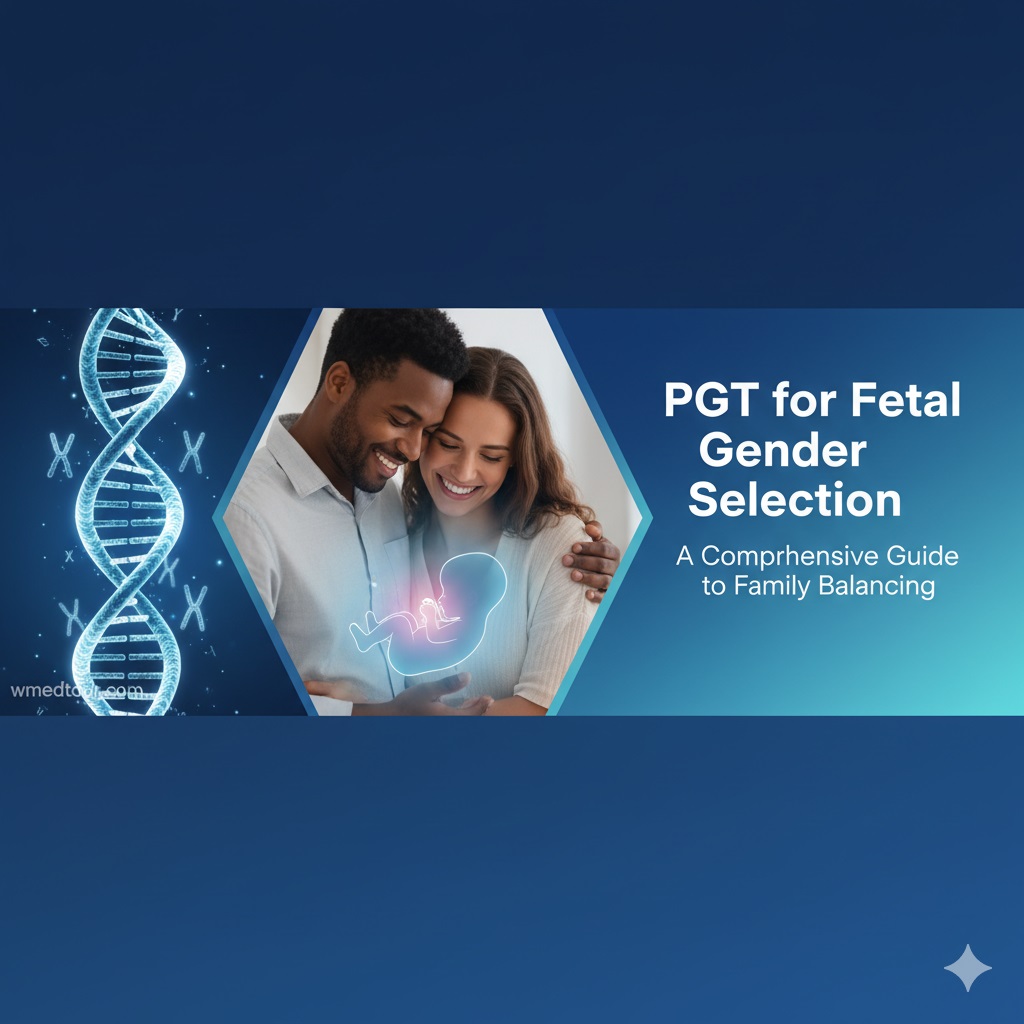The journey to parenthood is deeply personal, and for many, the dream includes a specific vision for their family’s composition. Whether it’s to experience the joy of raising both a son and a daughter or for medical reasons, the desire for family balancing is a significant motivation for many couples. In the past, choosing a baby’s gender was left to chance and folklore. Today, however, advances in reproductive medicine have made it possible. The most effective of these technologies is PGT for fetal gender selection.
This guide will walk you through every aspect of this process, from the underlying science to the practical steps involved. We’ll explore the pros and cons, success rates, and the crucial ethical and legal questions you should consider. Our goal is to provide you with authoritative, clear, and empathetic information to help you make the best decision for your family.
Understanding the Core Technology: What is PGT?
Preimplantation Genetic Testing (PGT) is a sophisticated scientific procedure used to analyze the genetics of an embryo before it is implanted in the uterus. Its primary purpose is to help identify healthy embryos, increasing the chances of a successful pregnancy and reducing the risk of passing on genetic disorders. The process of analyzing an embryo’s chromosomes for abnormalities is specifically called PGT-A (Preimplantation Genetic Testing for Aneuploidy).
A crucial byproduct of this comprehensive chromosomal analysis is the identification of the sex chromosomes. Embryos with two X chromosomes (XX) will develop as females, while those with an X and a Y chromosome (XY) will develop as males. Because PGT can clearly distinguish between them, it has become the gold standard for gender selection. This is a significant step beyond older, less reliable gender selection methods.
The Step-by-Step Process of PGT for Fetal Gender Selection
Choosing your baby’s gender with PGT is not a standalone procedure; it’s an integral part of an IVF cycle. Here is a breakdown of the journey:
- Ovarian Stimulation: The process begins with the female partner taking fertility medications to stimulate her ovaries to produce multiple eggs, rather than the single egg in a natural cycle.
- Egg Retrieval: Once the eggs are mature, they are retrieved in a minor surgical procedure performed under sedation.
- Fertilization: In the lab, the retrieved eggs are fertilized with sperm from the male partner or a donor. Often, a technique called ICSI (Intracytoplasmic Sperm Injection) is used, where a single sperm is injected directly into each egg to maximize fertilization rates.
- Embryo Culture: The resulting embryos are cultured in the lab for 5 to 6 days until they reach the blastocyst stage—a critical developmental milestone.
- Embryo Biopsy: A highly skilled embryologist carefully removes a few cells from the trophectoderm of each blastocyst (the part that later forms the placenta). This step is delicate but has a very low risk to the embryo’s health. For more information on this, Stanford Medicine provides an overview.
- Genetic Testing: The biopsied cells are sent to a genetics lab where they are analyzed to count the chromosomes (checking for aneuploidy with PGT-A) and identify the sex chromosomes (XX or XY). You can read about the accuracy of this testing in our PGT-A accuracy guide.
- Embryo Transfer: Once the results are in, you can decide which healthy embryo of your desired gender to transfer into the uterus. Remaining healthy embryos can be frozen for future use.
Who Is This For?
PGT for fetal gender selection is a powerful tool, but it’s not for everyone. This procedure is primarily intended for:
- Couples Seeking Family Balancing: Individuals who already have one or more children of one gender and wish to have a child of another gender to round out their family experience.
- Carriers of Sex-Linked Genetic Disorders: This is a critical medical application. For parents who are carriers of genetic diseases that affect a specific sex (like Duchenne muscular dystrophy or hemophilia, which primarily affect males), PGT can ensure they have a child of the unaffected gender. This medical necessity is a cornerstone of ethical gender selection discussed by institutions like the Johns Hopkins University.
- Patients Already Undergoing IVF: For those who need IVF for infertility reasons, adding PGT for gender selection can be a logical next step, as they are already committed to the core process. Our guide on IVF abroad can provide more context.
A Balanced View: Pros and Cons of PGT for Gender Selection
Making an informed decision requires weighing the benefits against the drawbacks. Here’s a clear breakdown:
Pros
- Unmatched Accuracy: It is nearly 100% accurate in determining the sex of the embryo.
- Family Balancing Fulfillment: Allows parents to achieve their desired family structure.
- Prevents Genetic Diseases: An essential tool for preventing the transmission of sex-linked hereditary disorders.
- Improved IVF Success: By selecting only chromosomally normal embryos (euploid) for transfer, PGT-A can increase the chances of implantation and reduce miscarriage rates, a topic explored in depth by UCLA Health’s fertility center.
- Peace of Mind: Provides reassurance that the transferred embryo is chromosomally healthy.
Cons
- High Cost: The procedure adds a significant expense to an already costly IVF cycle. See our analysis of the cost of fetal gender selection for more details.
- Invasive Nature: It requires a full IVF cycle, including hormone injections and surgical egg retrieval, which has associated risks and side effects.
- No Pregnancy Guarantee: Selecting a healthy embryo does not guarantee it will implant and result in a live birth. IVF success rates vary based on age and other health factors.
- Ethical and Moral Debates: The use of PGT for non-medical reasons is a subject of ongoing ethical debate, as outlined in our ethics guide.
- Emotional Toll: The process can be emotionally draining, filled with high hopes and potential disappointments.
Comparison of Gender Selection Methods
To understand why PGT for fetal gender selection is the preferred method, it’s helpful to compare it to other techniques.
| Method | Accuracy | Scientific Basis | Recommendation |
|---|---|---|---|
| PGT with IVF | ~99.9% | Strong (Direct chromosomal analysis) | Gold Standard |
| Sperm Sorting (e.g., MicroSort) | 70-90% | Moderate (Based on DNA mass difference) | Less reliable; not widely available |
| Shettles Method (Timing) | < 50% (Chance) | Weak (Disproven theory) | Not recommended |
| Dietary Methods | < 50% (Chance) | None (No scientific evidence) | Not recommended |
A Patient’s Journey: A Case Study
Case Study: The Journey of Sarah and Mark
Sarah and Mark, a couple in their mid-30s, were proud parents of two energetic boys. While they loved their sons dearly, they both dreamed of adding a daughter to their family. After researching their options, they decided against leaving it to chance and explored medical solutions. They learned about PGT for fetal gender selection and felt it was the right path for them. They consulted with a fertility specialist who walked them through the IVF process.
The journey was demanding, involving daily injections for Sarah and multiple clinic visits. After the egg retrieval, seven embryos were created. Five days later, all seven had reached the blastocyst stage and were biopsied. The wait for the genetic results was nerve-wracking. Finally, the news came: they had four chromosomally normal embryos—two male and two female. Overjoyed, they proceeded with the transfer of one healthy female embryo. Two weeks later, they received the call they had been hoping for: Sarah was pregnant. Nine months later, they welcomed their daughter, Mia, completing their family just as they had envisioned.
Navigating the Globe: Legal and Ethical Landscapes
The decision to pursue PGT for fetal gender selection is not just a medical one; it is also subject to legal and ethical frameworks that differ dramatically around the world. In some countries, like the United States, Cyprus, and Thailand, gender selection for family balancing is legally permitted. This has made them popular destinations for medical tourism. The legal aspects are further discussed by educational bodies like Harvard Law School.
Conversely, many other nations, including Canada, the United Kingdom, Germany, and Australia, have banned or strictly limited its use to medically necessary cases, such as preventing sex-linked diseases. These restrictions are often rooted in ethical concerns about gender discrimination and the commodification of children. Before proceeding, it is crucial to research the global medical treatment regulations and choose a clinic in a jurisdiction where the practice is legal and well-regulated. Explore our guide on the best countries for fetal gender selection to learn more.
Frequently Asked Questions (FAQ)
Is PGT for gender selection 100% accurate?
The accuracy of PGT in determining the chromosomal sex (XX for female, XY for male) of an embryo is nearly 100%. However, this does not guarantee a 100% chance of a successful pregnancy and live birth after the embryo is transferred. The ethical implications of this technology are often discussed by leading academic institutions, such as the University of Pittsburgh’s Center for Bioethics.
Can I do PGT without IVF?
No, PGT cannot be performed without undergoing an IVF (In Vitro Fertilization) cycle. The process requires creating embryos in a laboratory so that a biopsy can be performed on them before they are transferred to the uterus. PGT is an add-on procedure to IVF.
Does PGT harm the embryo?
The risk of harm to the embryo from a biopsy is very low when performed by a skilled embryologist. The few cells are typically taken from the trophectoderm (the part that will become the placenta), not the inner cell mass (which develops into the fetus). Stanford University’s research confirms that embryo biopsy is a safe procedure in experienced hands. For more details on this you can read our PGT-A guide for gender selection.
How much does PGT for fetal gender selection cost?
The cost varies significantly by country and clinic. PGT itself can add several thousand dollars to the total cost of an IVF cycle. For a detailed breakdown, you can explore our guide on the cost of fetal gender selection.
Are there any non-invasive alternatives to PGT for gender selection?
While methods like sperm sorting exist, their accuracy is significantly lower than PGT and they are not widely endorsed by the medical community for reliability. PGT remains the only highly accurate method for pre-conception gender selection. Other popular theories like diet or timing methods have no scientific backing.
How long does the entire process take, from starting IVF to embryo transfer?
A full IVF cycle with PGT typically takes about 4 to 6 weeks. This includes ovarian stimulation (about 2 weeks), egg retrieval, fertilization, embryo growth (5-6 days), genetic testing (which can take 1-2 weeks for results), and finally, the frozen embryo transfer in a subsequent cycle. Preparing for this journey involves a pre-travel checklist if you’re going abroad.
What happens to the embryos that are not of the desired gender?
Parents have several options for healthy embryos that are not selected for transfer. They can choose to keep them frozen for future use, donate them to another couple, donate them to scientific research, or request that the clinic compassionately disposes of them. This is a profound decision, and the University of Wisconsin School of Medicine provides resources on this topic.
Can PGT increase the chance of having a healthy baby?
Yes, specifically PGT-A (Preimplantation Genetic Testing for Aneuploidy) screens embryos for the correct number of chromosomes. Transferring a chromosomally normal (euploid) embryo reduces the risk of miscarriage and genetic disorders like Down syndrome, thereby increasing the chance of a healthy live birth. This is especially important for women of advanced maternal age. To learn more on this you can read our new methods in IVF guide.
Is gender selection legal everywhere?
No. The legality of gender selection for non-medical reasons (family balancing) varies greatly. It is permitted in countries like the UAE, Mexico, Cyprus, and Iran, but it is banned or heavily restricted in Canada, the UK, Australia, India, and most of Europe. We have a detailed guide on the legal countries for various medical procedures.
What is the difference between PGT-A and PGD?
PGT-A (for Aneuploidy) screens for the overall number of chromosomes in an embryo to ensure it’s normal. PGD (for Monogenic/Single Gene Defects), now often called PGT-M, tests for specific inherited genetic diseases like Cystic Fibrosis or Huntington’s Disease. Both can determine the embryo’s sex. Some clinics even use AI to improve treatment precision.
Does insurance cover the cost of PGT for family balancing?
Generally, no. When PGT is used for elective family balancing, it is considered a non-medically necessary procedure and is typically not covered by insurance. Coverage may be available if it’s used to prevent a sex-linked genetic disease. Understanding the cost of medical treatments abroad can help in financial planning.
What are the emotional considerations when choosing PGT for gender selection?
The IVF and PGT process can be an emotional rollercoaster. It involves hope, anxiety, potential disappointment if the cycle fails or no healthy embryos of the desired sex are produced, and complex decisions about unused embryos. Seeking counseling and support from professionals, like those at the University of Pittsburgh’s psychology department, is highly recommended.




